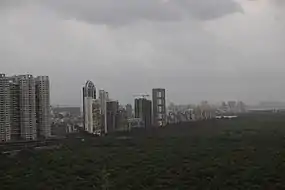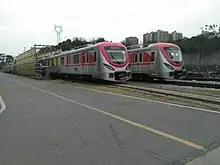Navi Mumbai
New Mumbai[1] | |
|---|---|
Form top left to right: Navi Mumbai Skyline, Vashi Sector 30A, Utsav Chowk, Vashi Sector 30A, Vashi Railway Station, Navi Mumbai Municipal Corporation, Seawoods Grand Central mall, PKP Airoli IT Park, Pandavkada Falls, Wonders Park, Seawoods Flamingo Refuge, Rajiv Gandhi Joggers Park | |
| Nickname: Flamingo City | |
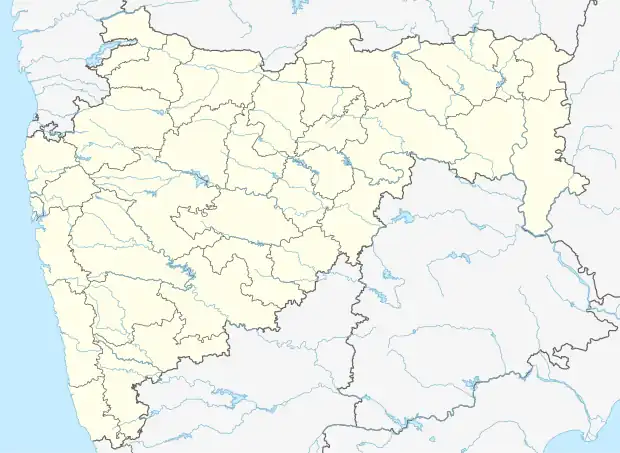 Navi Mumbai Navi Mumbai  Navi Mumbai Navi Mumbai (India) 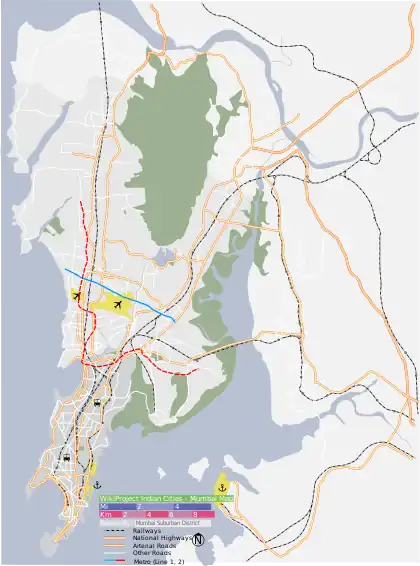 Navi Mumbai Navi Mumbai (Mumbai) | |
| Coordinates: 19°01′N 73°01′E / 19.02°N 73.02°E | |
| Country | |
| State | |
| Division | Konkan |
| District | Thane District Raigad District |
| Planned and Developed by | CIDCO |
| Government | |
| • Type | Municipal Corporation |
| • Body | Navi Mumbai Municipal Corporation (Thane District) Panvel Municipal Corporation (Raigad District) |
| Area | |
| • Total | 344 km2 (133 sq mi) |
| Elevation | 14 m (46 ft) |
| Population | |
| • Total | 1,618,000 |
| Demonym | Navi Mumbaikar |
| Time zone | UTC+5:30 (IST) |
| Vehicle registration | MH-43 (Thane district) MH-46 (Raigad district) |
Navi Mumbai (lit. 'New Mumbai', Marathi pronunciation: [nəʋiː mumbəi]) is a planned city that is adjacent to Mumbai, located in the Konkan division of Maharashtra state, on the mainland of India. Navi Mumbai is situated across two districts, Thane & Raigad. It is a part of the Mumbai Metropolitan Area.
The city has been ranked 3rd among 73 cities surveyed for cleanliness and hygiene by the Union Ministry of Urban Development (MoUD) and Quality Council of India (QCI) as a part of Swachh Bharat Abhiyan.[2]
Navi Mumbai is home to various educational institutions. Various multinational corporations have their head offices/branches across the city, making it an active business hub. Navi Mumbai also has various recreational facilities such as a Golf Course, Central Park and Pandavkada Water Falls in Kharghar. Thane Belapur Marg and Palm Beach Marg are major business attraction and upmarket residential areas respectively.
History
The city's or area history dates back to the late 1500s when Siddis of Janjira built the Belapur Killa located atop a hillock, near the mouth of the Panvel Creek. In 1682, the fort was captured by the Portuguese, who had managed to annex the regions controlled by the Siddis, near Belapur.
In 1733, the Marathas, led by Chimaji Appa, wrested control of the fort from the Portuguese. He had made a vow that if it were to be successfully recaptured from the Portuguese, he would place a garland of beli leaves in a nearby Amruthaishwar temple, and after the victory the fort was christened as Belapur Fort. The Marathas ruled the area until 23 June 1817, when it was captured by Captain Charles Gray of the British East India Company. The British partially destroyed the fort under their policy of razing any Maratha stronghold in the area.
Planning and Development
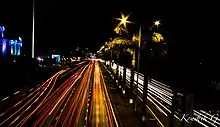
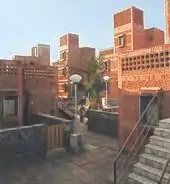



The population of Greater Mumbai rose from 2.966 million in 1951 to 4.152 million in 1961 and to 5.970 million in 1971. The rapid rate of growth of population resulted in a fast deterioration in the quality of life for the majority of people living in the city.
The Government of Maharashtra formed a committee under the Chairmanship of Prof. D. R. Gadgil and asked: “to formulate broad principles of regional planning for the metropolitan regions of Mumbai Panvel and Pune and to make recommendations for the establishment of Metropolitan Authorities for preparation and execution of such plans”.
The Gadgil Committee inter-alia made two important recommendations which have influenced the planning for Navi Mumbai. One, a planned decentralisation of industries with severe restrictions on further industrial growth in the Bombay region. Two, development of the mainland area as a multi-nucleated settlement, each settlement smaller in size than 250,000 population.
The Maharashtra Regional and Town Planning Act was passed in 1966 and brought into force in January 1967. The Bombay Metropolitan Region was notified in June 1967 and a Regional Planning Board constituted under the Chairmanship of Shri L. G. Rajwade, I. C. S. The Draft Regional Plan of the Board was finalised in January 1970. It proposed the development of a twin city across the harbour, on the mainland to the east, as a counter-magnet to the office concentration taking place at the southern tip of Bombay.
The Board recommended that the new metro-centre or Navi Mumbai as it is now called, be developed to accommodate a population of 2.1 million.[3]
The planning of Navi Mumbai began in 1971 and involved leading architects and urban planner like Adi Kanga, Charles Correa (Chief Architect), Shirish Patel, Pravina Mehta[4] and R. K. Jha (Chief Planner),[5] The City and Industrial Development Corporation (CIDCO) was established on 17 March 1971, under the Indian Companies Act, 1956 for this purpose. The area covered 150 kilometres (93 mi) of the total 720 kilometres (450 mi) of the Konkan coast. Privately owned land consisting of 86 villages covering 15,954 hectares (39,420 acres) within the present limits of Navi Mumbai and further villages measuring an additional 2,870 hectares (7,100 acres) were acquired by the government of Maharashtra.[6] Navi Mumbai covers the southern part of Thane taluka (from Thane District) and part of Panvel and Uran talukas (from Raigad District).
CIDCO carved out 19 small nodes with a view towards facilitating comprehensive development. These nodes were named Airoli, Ghansoli, Kopar Khairane, Juhu Nagar, Vashi, Turbhe, Sanpada, Juinagar, Nerul, Seawoods (Darave), Karave Nagar, CBD Belapur, Kharghar, Kamothe, New Panvel, Kalamboli, Ulwe, Dronagiri and Taloja.
CIDCO planned and constructed all the railway stations, roads and public spaces in Navi Mumbai and developed nearby areas commercially.
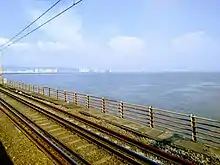
In 1973, the Vashi bridge was opened to the public for residents of Vashi, CBD Belapur and Nerul. The Sion-Panvel Highway was built to reduce the time taken to travel from Sion to Panvel. Initially, there was not much response to the new city. Major changes took place only after 1990, with the commissioning of a wholesale agricultural produce market at Turbhe and the construction of a commuter railway line from Mankhurd to Vashi in May 1992. These developments caused a sudden growth in economic activities and population in Navi Mumbai.
The city was originally planned to create affordable housing for people who could not afford living in Mumbai. It was decided not to let any slum pockets pop up across the city, however, according to the 2001 census, a fifth[7][8] to a third[9] of the population of municipalized Navi Mumbai live in slums [10] and gaothans (urban villages),[6] with thousands of buildings violating planning norms.[11]
By the end of the 1990s, the planning authority of Navi Mumbai initiated private participation in the developmental activity of Navi Mumbai. A new railway link between Nerul and Uran was inaugurated on 11 November 2018.[12] Southern Navi Mumbai is being developed rapidly with its class infrastructure and modern nodes of Kharghar, Kamothe, Panvel and Kalamboli. These nodes are experiencing major infrastructural developments due to their proximity to the proposed Navi Mumbai International Airport. Also, the latest development known as 'One Time Planning' with an estimated budget of ₹12,821 crores is underway to transform the municipalized Navi Mumbai on the lines of the Mega Cities of the world.
Flora And Fauna
A significant part of Flamingos that settle in the Greater Mumbai Region are found in Navi Mumbai.[13][14][15]
Administration
CIDCO
When Navi Mumbai was created in the 1970s, CIDCO was the only authority that looked after the development and maintenance of the city. CIDCO prepared a developmental plan for Navi Mumbai covering 95 villages all over the city.

For the first ten years of the project CIDCO acted as the planning and administrative body and as the developer and builder for the project. Taxes on property, land, commercial and water were payable to CIDCO.
CIDCO planned 14 nodes divided into the North and the South part.[16] The 7 nodes in the North part are Airoli node, Ghansoli node, Kopar Khairane node, Vashi node, Sanpada node, Nerul node and Belapur node. The 7 nodes in the South part are Kharghar node, Kamothe node, Kalamboli node, Pushpak Nagar node, Panvel node, Ulwe node and Dronagiri node. Also, two municipal bodies have been established, Navi Mumbai Municipal Corporation (NMMC) in the North and Panvel Municipal Corporation in the South. Each of the nodes is divided into smaller groups called sectors.
Initially only Juhu Nagar, Vashi, Nerul and CBD Belapur were developed by CIDCO with housing, schools and community centre roads. But after the arrival of the harbour railway line extension in the 1990s, there was an increase in population. CIDCO shifted its development plan to nodes like Kharghar, Kamothe, New Panvel and Kopar Khairane. In its new development plan, CIDCO land was allocated to builders for housing. CIDCO only provided basic infrastructure like roads, water and electricity, these nodes were developed mostly by private builders according to the CIDCO plan.
The newly developed nodes of Navi Mumbai on the south side like Kharghar, Kamothe, New Panvel and Kalamboli are maintained by CIDCO. These nodes, which are all beyond CBD Belapur, come under the Raigad district.
State government has asked CIDCO to develop South Navi Mumbai as a smart city as it will be a role model for other states in the country. Smart City project includes, Navi Mumbai International Airport, Mumbai Trans Harbour Link connecting Ulwe with Sewri, a long coastal link from Dronagiri, extension of the Palm Beach Road from Kopar Khairane to Airoli, extension of national highway, local train railway from Panvel to Ulwe and Uran, new metro projects, including CBD Belapur, Taloja, Khandeshwar and Navi Mumbai airport metro project, development of fourth container terminal in JNPT, new greenfield cities, one near Uran, affordable housing schemes for low income groups and Project Affected Peoples (PAPs), new parks, playgrounds, auditoriums, bhavans, noise and air quality index checkers using advanced technologies, modern sewage treatment plants. CIDCO has its own plan of developing the area under its jurisdiction (informally called as Navi Mumbai South) as a smart city. Everything will be completed by 2022, except the airport.[17][18]
Navi Mumbai Municipal Corporation
On 17 December 1991, Navi Mumbai Municipal Corporation (NMMC) was constituted by the state government for maintaining some of the developed nodes of Navi Mumbai.
Local self-government started on 1 January 1992. NMMC was handed seven of the 14 nodes of the Navi Mumbai project area for its jurisdiction. However, CIDCO, as a planning authority, has rights on the open plots in these seven nodes.
The NMMC jurisdiction starts at Digha in the North and ends at Belapur in the South.[19] The NMMC area is planned into seven nodes (zones) - Belapur, Nerul, Sanpada, Vashi, Kopar Khairane, Ghansoli and Airoli.

Navi Mumbai Municipal Corporation is rated amongst the richest corporations in Maharashtra.
The Municipal Corporation is headed by a Municipal Commissioner and an elected Mayor.
Panvel Municipal Corporation
Panvel Municipal Council (PMC), which previously administered the city of Old Panvel, was upgraded from Municipal Council to a Municipal Corporation[20][21] after incorporating the adjacent nodes of Navi Mumbai under CIDCO's jurisdiction and surrounding villages in the proposed Panvel Municipal Corporation.[22]
Demographics
| Year | Pop. | ±% |
|---|---|---|
| 1981 | 8,062 | — |
| 1991 | 307,724 | +3717.0% |
| 2001 | 704,002 | +128.8% |
| 2011 | 1,120,547 | +59.2% |
| Source: Government of India[24] | ||
As per provisional reports of Census India, population of Navi Mumbai in 2011 is 1,120,547; out of which males and females are 610,060 and 510,487 respectively. Although Navi Mumbai has population of 1,120,547, its urban / metropolitan population is 18,414,288 of which 9,894,088 are males and 8,520,200 are females. At least 65.5% of population speaks Marathi language in Navi Mumbai.
Total number of literate individuals in Navi Mumbai is 911,542. Out of this number, 519,257 are males while 392,285 are females. Average literacy rate of Navi Mumbai is 91.57 percent of which male and female literacy was 95.05 and 87.33 percent. The sex ratio of Navi Mumbai is 831 females per 1000 males. Child sex ratio of girls is 901 per 1000 boys.
Transport and infrastructure




Navi Mumbai has a robust infrastructure, is well connected to other parts of the state and country and is relatively less polluted compared to Mumbai. The city has a good public transportation system with NMMT, the transport wing of NMMC, serving the bus commuters, the Mumbai suburban railway serving the train commuters and a large fleet of auto rickshaws for intra-nodal commute. The Mumbai-Pune Expressway starts at Kalamboli in Navi Mumbai. The Mumbai Trans Harbour Link (MTHL), also known as the Sewri-Nhava Sheva Trans Harbour Link, is a 22-kilometre (14 mi) long freeway grade road bridge connecting South Mumbai with Navi Mumbai.[25] It was opened on 12 January 2024, after Prime Minister Narendra Modi inaugurates the bridge. [26][27]
The Mumbai suburban railway network covers most of the populated regions of the city. The most important suburban stations are Vashi, Nerul, Belapur and Panvel. The stations are planned as major railway junctions. Panvel is the only mainline station and also the busiest railway station of Navi Mumbai. All outstation trains halt here for time periods varying from 5 to 20 minutes. It is an important junction, railway lines come and meet here and it is connected to almost all parts of India. A new broad gauge line is functional between Karjat & Panvel.
Brihanmumbai Electric Supply and Transport (BEST) buses run from various area of Mumbai to Navi Mumbai & Navi Mumbai Municipal Transport (NMMT) buses run all over Navi Mumbai and various area in Mumbai, Thane, Bhiwandi, Kalyan-Dombivli-Badlapur, Panvel-Khopoli-Taloja, Uran-Ulwe etc. The Palm Beach Marg, a 10-kilometre (6.2 mi) long six lane road connects Vashi to CBD Belapur running parallel to the Thane Creek.
Auto rickshaws provide inter as well as intra nodal public transport across the city. Taxis operating from designated taxi stands provide the means to travel to further destinations. Taxis charge a fixed rate approved by the R. T. O. details of which can be found on popular local transit apps of the city.[28]
Navi Mumbai has the largest container terminal in India, Jawaharlal Nehru Port at Nhava Sheva near Uran.[29] It is well connected by road and rail, and handles approximately 56.13% of India's container traffic.[30][31] The Chhatrapati Shivaji Maharaj International Airport, 30 km away, is the nearest airport to the city.
International Airport
The Navi Mumbai International Airport[32] is being constructed in southern Panvel near Ulwe. It is being built through Public Private Partnership (PPP), with private sector partners having 74% equity and the Airports Authority of India (AAI) and Government of Maharashtra (through CIDCO) each holding 13%.
The International Civil Aviation Organization (ICAO) has already given techno-feasibility clearance to the airport. The central government provided cabinet approval for the construction on 31 May 2007. The airport's construction was started in August 2021,[33] and is expected to be fully operational by December 2024.[34]
Metro
The Navi Mumbai Metro is a new rapid transit system serving the city. A network of as many as five lines has been planned, of which four lines will be constructed by CIDCO in the Navi Mumbai south region, while the second and third lines of the metro system will be constructed by NMMC and MMRDA, respectively.[35] The first line of the metro system was completed by CIDCO and was opened to the public on 17 November 2023, after several delays spanning for around a decade due to various construction and land acquisition issues. This line includes three phases. In the first phase, the line joins the CBD Belapur station on the Mumbai suburban railway and Pendhar village.[36][37] In the second phase, the line will join Taloja MIDC and Khandeshwar node (which will be extended to the under-construction Navi Mumbai International Airport in Ulwe node of the city), and in the third phase, the line will link the Pendhar and Taloja MIDC metro stations. The cost of the metro project has risen from 4,163 crore for 21.45 km in 2011 to 8,904 crore for 26.26 km in 2018.[35]
Other infrastructure
The city boasts a reliable supply of electricity from various sources, and excellent motoring conditions, with numerous flyovers, broad roads, and parking lots. A hovercraft service from Vashi to Colaba and the CBD to Colaba did not succeed due to the high cost of tickets and maintenance. CIDCO is planning to relaunch its hovercraft service from Vashi, Belapur, Nerul and Airoli to Gateway of India.
Services
There are adequate utility services, banks, restaurants, malls, multiplexes and other shops in Navi Mumbai. The City boasts several shopping malls such as Little World Mall, Glomax Mall, Prime mall and Pacific Mall in the most developed node of Navi Mumbai, Kharghar; K-Mall and the Orion Mall in Panvel node of the city; Center One, Palm Beach Galleria, Citi Center, Raghuleela Mall and Inorbit Mall in Vashi, along with the Seawoods Nexus Mall in Seawoods. Throughout Navi Mumbai, supermarkets and hypermarkets like Big Bazaar, Reliance Smart, Reliance Smart points, Apna Bazaar, More, Spencer's, Reliance Fresh, Spinach, Daily Bazar and Fairprice cater to the shopping needs of the residents. DMart has launched eight hypermarkets in Navi Mumbai.
Leading banks such as Bank of India, Punjab National Bank, South Indian Bank, State Bank of India, Union Bank, Saraswat Bank, Bank of Baroda, AXIS Bank, Canara Bank, Oriental Bank of Commerce, Central Bank of India, Bank of Maharashtra, State Bank of Hyderabad, Citibank India, ICICI Bank, Jammu & Kashmir Bank, Citi Bank, HSBC Bank and HDFC Bank have their branches and ATMs around Navi Mumbai. The Reserve Bank of India has served the people of Navi Mumbai since 2001.
Navi Mumbai has some three-star and five-star hotels; namely Royal Tulip (five-star hotel in Kharghar), The Hotel Three Star (In Kharghar), The Park (Belapur CBD), Fortune Select Exotica-Member ITC Hotel Group (Vashi), The Regenza by Tunga (Vashi), Four Points by Sheraton (Vashi) & Hotel Yogi Executive (Vashi) to name a few.
Commerce
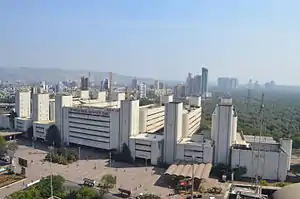


The Navi Mumbai Special Economic Zone (SEZ) located in the nodes of Dronagiri and Kalamboli are planned to provide commercial growth and employment to the city. Positioned en route to the proposed Navi Mumbai Airport, this megaproject has attracted investments of close to 40,000 crores. Navi Mumbai is a new hub for newly incorporated companies & start ups to establish their base in Mumbai.[38] As per the list of newly incorporated companies in Navi Mumbai around 500 new & startup companies were registered in and around the region every month.
Sports
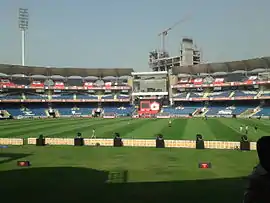
Cricket is the most popular sport in the city. Navi Mumbai has its own International Cricket Stadium in Shiravne (Nerul) called the DY Patil Stadium which hosts IPL T-20 matches, including hosting the 2008[39] and 2010 IPL finals. It was one of the two venues for the inaugural edition of the Women's Premier League (WPL) in 2023.[40] It is also the home ground for the Indian Super League football club Mumbai City FC. The Fr. Agnel Stadium in Vashi is the training ground of the team.
Navi Mumbai was one of the host cities of the 2017 FIFA U-17 Men's World Cup and the 2022 FIFA U-17 Women's World Cup with the DY Patil Stadium hosting the final of the event in 2022.[41][42]
Navi Mumbai Sports Association[43] is the oldest sports complex in Navi Mumbai, NMSA has contributed significantly to the sports world by creating international level athletes from Navi Mumbai. Navi Mumbai has an Olympic-size swimming pool at Nerul. CIDCO has proposed two 18-hole golf course academies at Nerul and Kharghar. There are plans to have sports facilities in the proposed 80 hectare Central Park being developed in Kharghar. The CIDCO has also constructed an 11-hole golf course in Kharghar near Central Park.
Education
Provision of schools and colleges was priority in the planning of Navi Mumbai. The nodes (townships) were designed to provide one primary school per 5,000 populations, one high school for 12,500 populations and one college for 50,000 population.
Each of the nodes is self-sufficient in terms of providing quality education. Students are given access to various syllabi, including the State Education Board, CBSE, IGCSE, IB and ICSE patterns. Other than this, CIDCO encouraged private institutions as well.
About 22.5% of the total population is considered to be school-going children. Most students attend school and college within their node (township). 76% of the students walk to their school or college, 12% use public transport, 10% use bicycles and only 2% travel by school bus.
A number of premier schools and colleges have been set up in Navi Mumbai. And not just local students, but students from Mumbai and even outside come to Navi Mumbai in their quest for quality education. As such, Navi Mumbai is quickly acquiring the title of educational hub.[44]
Colleges
Engineering Colleges
- Fr. Conceicao Rodrigues Institute of Technology, Vashi
- Datta Meghe College of Engineering, Airoli
- Indian Institution of Industrial Engineering, Belapur
- Lokmanya Tilak College of Engineering, Koparkhairane
- Ramrao Adik Institute of Technology, Nerul
- SIES Graduate School of Technology, Nerul
- Terna Engineering College, Nerul
Schools
- Avalon Heights International School
- Bharati Vidyapeeth Institute of Technology
- D. A. V. Public School, Nerul
- Dayanand Anglo Vedic Public School, Airoli
- Delhi Public School, Nerul
- Fr. Agnel Multipurpose School and Junior College, Vashi
- Ryan International Schools, Sanpada, Kharghar, Vashi, Kalamboli
- Seventh-Day Adventist Higher Secondary School (ICSE & ISC)
- VIBGYOR Group of Schools, Airoli
- VIBGYOR Group of Schools, Kharghar
- Vishwajyot High School, Kharghar
See also
References
- ↑ Verma, Harnam Singh (5 January 1985). "Bombay, New Bombay, and Metropolitan Region: Growth Process and Planning Lessons".
- ↑ "Swachh Survekshan −2016 – ranks of 73 cities". pib.nic.in. Archived from the original on 20 February 2016. Retrieved 10 August 2017.
- ↑ "CIDCO :: Evolution of Navi Mumbai". Cidco.maharashtra.gov.in. Archived from the original on 10 August 2017. Retrieved 10 August 2017.
- ↑ "Master class with Charles Correa". Mumbai Mirror. 9 June 2013. Archived from the original on 13 June 2013. Retrieved 2 July 2013.
- ↑ Mehta, H.: Man who built Navi Mumbai is in Gujarat Archived 2 February 2014 at the Wayback Machine The Times of India, 21 February 2010. Accessed 27 January 2014.
- 1 2 Chatterjee, Piu (7 July 2014). "Urban Villages in Globalized India: Degenerative Growth Processes in Navi Mumbai". Inclusive. Journal of the Kolkata Centre for Contemporary Studies. ISSN 2278-9758. Archived from the original on 26 October 2015.
- ↑ "Slum population-- 2001 Census" (PDF). Visionmumbai.org. Archived from the original (PDF) on 12 September 2015. Retrieved 28 October 2015.
- ↑ Srivastav, Amit (15 December 2012). "Slum-hub". Afternoon Despatch & Courier, Mumbai. Archived from the original on 10 August 2017. Retrieved 28 October 2015.
- ↑ Vijapurkar, Mahesh (18 June 2015). "Navi Mumbai was Charles Correa's dream: Here's how it turned into a nightmare". Firstpost. Archived from the original on 21 June 2015. Retrieved 27 June 2015.
- ↑ "Slum and Non-Slum Population, Sex ratio and Literacy rate by City/ Towns, in Maharashtra State 2001". ENVIS Centre on Population and Environment (Ministry of Environment & Forests, Govt. of India). Archived from the original on 9 November 2015. Retrieved 28 October 2015.
- ↑ Bhosale, Arpika (12 April 2013). "23,000 illegal two-storey buildings in Navi Mumbai". Free Press Journal. Archived from the original on 4 February 2016. Retrieved 28 October 2015.
- ↑ "uran rail line commissioned: Mumbai: First phase of Nerul-Seawoods-Uran rail line commissioned". The Times of India. 11 November 2018. Retrieved 23 January 2020.
- ↑ Mohta, Payal (26 March 2019). "'A double-edged sword': Mumbai pollution 'perfect' for flamingos". The Guardian. ISSN 0261-3077. Retrieved 28 March 2023.
- ↑ "Over 100,000 Flamingos Reportedly Descend on Mumbai Amid India's Strict Coronavirus Lockdown". Time. 2 May 2020. Retrieved 28 March 2023.
- ↑ "Flamingos turn Mumbai lakes into 'sea of pink'". BBC News. Retrieved 28 March 2023.
- ↑ "Development Plan". CIDCO. 19 December 2017. Archived from the original on 10 April 2021. Retrieved 12 March 2021.
- ↑ "CIDCO announces Rs 34,000-crore smart city project", The Hindu, Mumbai, 3 December 2015, retrieved 20 December 2015
- ↑ BS Reporter (5 December 2015), "Cidco launches Navi Mumbai smart city project", Business Standard India, Mumbai: Business Standard, archived from the original on 22 December 2015, retrieved 20 December 2015
- ↑ "Zoning". NMMC. Retrieved 12 March 2021.
- ↑ U K Nambiar (12 December 2015), Talks begin to give corporation status to PMC, Navi Mumbai: TOI, TNN, archived from the original on 6 August 2016, retrieved 20 December 2015
- ↑ Bhavika Jain (9 December 2015), 2 new civic bodies on cards, Mumbai: TOI, TNN, archived from the original on 10 December 2015, retrieved 20 December 2015
- ↑ Umesh K Parida (20 December 2015), PMC's civic body plan includes 3 more villages, Navi Mumbai: TOI, TNN, archived from the original on 9 August 2017, retrieved 20 December 2015
- ↑ "Navi Mumbai Population 2011". Census 2011.
- ↑ "Census Tables". censusindia.gov.in. Retrieved 6 January 2024.
- ↑ "Mumbai Trans-Harbour Link May Be Ready Before 2022 Deadline, Says Chief Minister Uddhav Thackeray". BloombergQuint. Retrieved 15 January 2020.
- ↑ https://www.indiatoday.in/india/story/mumbai-trans-harbour-link-photos-videos-cost-mthl-traffic-rules-mumbai-police-2487221-2024-01-11
- ↑ https://www.livemint.com/news/india/atal-setu-indias-longest-bridge-news-pm-modi-inaugurate-mumbai-trans-harbour-link-mthl-today-11705023137497.html
- ↑ Kamal, Hassan (29 June 2015). "Good news for the daily commuter". Mid-day.com. Mid-Day. Archived from the original on 2 August 2015. Retrieved 12 August 2015.
- ↑ "India's major ports see 6.7 percent growth in container volumes". JOC.com. 7 April 2010. Archived from the original on 7 May 2015. Retrieved 27 June 2015.
- ↑ "JNPT's 12-lane freight corridor to ease traffic snarls around Mumbai". The Hindu. Archived from the original on 30 December 2016. Retrieved 27 February 2017.
- ↑ "JNPT". Jnport.gov.in. Archived from the original on 1 August 2017. Retrieved 10 August 2017.
- ↑ "GMR cites 'execution challenges', may exit Navi Mumbai airport project". The Hindu. Retrieved 27 February 2017.
- ↑ "Construction of Navi Mumbai Airport expected to begin from August: Adani". Hindustan Times. 24 July 2021. Retrieved 16 May 2022.
- ↑ "Navi Mumbai International Airport project finally takes off as all hurdles cleared". Hindustan Times. 26 April 2022. Retrieved 16 May 2022.
- 1 2 "Introduction". CIDCO. 2012. Retrieved 18 November 2023.
- ↑ Assainar, Raina (25 October 2023). "Residents miffed as Navi Mumbai Metro awaits inauguration". Hindustan Times. Retrieved 18 November 2023.
- ↑ Ganapatye, Mayuresh (17 November 2023). "Navi Mumbai Metro Starts Today After 12-Year Wait, First Service at 3pm from Pendhar-Belapur Terminal". News18. Retrieved 18 November 2023.
- ↑ "New| upcoming Companies in Navi Mumbai List". Archived from the original on 5 June 2014. Retrieved 1 June 2014.
- ↑ Sengupta, Somini (7 May 2008). "Bright Lights and Big Money in India's New Cricket League". The New York Times. ISSN 0362-4331. Retrieved 28 March 2023.
- ↑ "Mumbai Indians, Gujarat Giants to kick off WPL 2023 in Navi Mumbai on March 4". ESPNcricinfo. 14 February 2023. Archived from the original on 3 April 2023. Retrieved 4 April 2023.
- ↑ "Navi Mumbai transforms from educational hub to football bastion for FIFA U-17 World Cup". The Times of India. 21 September 2017. Archived from the original on 3 April 2023. Retrieved 4 April 2023.
- ↑ "FIFA U-17 Women's World Cup 2022: Navi Mumbai to host final, India to play group stage in Bhubaneswar". ESPN. 15 June 2022. Archived from the original on 3 April 2023. Retrieved 4 April 2023.
- ↑ Gajaria, Vishal. "India to host another ITF event". Tennis World USA.
- ↑ "CIDCO :: Educational Infrastructure". Cidco.maharashtra.gov.in. Archived from the original on 10 August 2017. Retrieved 10 August 2017.
External links
 Navi Mumbai travel guide from Wikivoyage
Navi Mumbai travel guide from Wikivoyage- "Places to Visit in Navi Mumbai", Tripoto, archived from the original on 17 March 2015, retrieved 2 November 2014
- Navi Mumbai Municipal Corporation Accessed 11 October 2012.
- Navi Mumbai Special Economic Zone Archived 30 December 2012 at the Wayback Machine
- CIDCO – City and Industrial Development Corporation Accessed 29 June 2013.
- Archived 2 October 2021 at the Wayback Machine navi Mumbai metro train trial
- Navi Mumbai RTO Code
